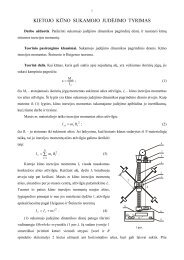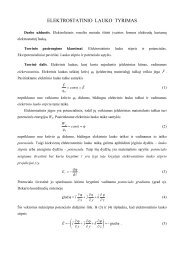PROCEEDINGS OF THE 7 INTERNATIONAL ... - Fizika
PROCEEDINGS OF THE 7 INTERNATIONAL ... - Fizika
PROCEEDINGS OF THE 7 INTERNATIONAL ... - Fizika
Create successful ePaper yourself
Turn your PDF publications into a flip-book with our unique Google optimized e-Paper software.
T. Landberg et al. / Medical Physics in the Baltic States 7 (2009) 43 - 51<br />
Fig. 7.<br />
Level 1:<br />
The requirements should be followed in all centers, for<br />
all patients. They constitute the standards below which<br />
safe and accurate radiotherapy cannot be performed. At<br />
this level, it is assumed that the dose at the ICRU<br />
Reference Point can be accurately determined as well as<br />
an estimate of the maximum and minimum doses to the<br />
PTV, using at least central-axis depth dose tables and<br />
standard isodose charts.<br />
Level 2:<br />
The standards of dose planning at this level allow the<br />
exchange of more complete and relevant information<br />
between different centers. At this level, it is assumed that<br />
the GTV, CTV, OR, PTV, and PRV can be defined using<br />
reliable patient data acquisition tools, and/or modern<br />
imaging techniques under reliable conditions (e.g., a<br />
series of CT and/or MRI sections). It is also assumed that<br />
complete dose distributions are available in planes or<br />
volumes, with inhomogeneity corrections, when<br />
appropriate. There must be a full quality assurance<br />
program covering the whole procedure.<br />
Level 3:<br />
Level 3 includes the development of new techniques for<br />
which reporting criteria are not yet established (e.g.<br />
BNCT, intensity modulation, etc.). Some procedures<br />
which are now at level 3 can become level 2 with the<br />
development of techniques, equipment and standards.<br />
Fig 8.<br />
50<br />
At any level, the dose at the ICRU Reference Point and<br />
the best estimation of the maximum and the minimum<br />
dose to the PTV should be reported. Furthermore, any<br />
additional relevant information should be given, when<br />
available, e.g. Dose-Volume-Histograms (DVHs). The<br />
absorbed doses to the Organs at Risk should also be<br />
given.<br />
Reporting Doses in a Series of Patients.<br />
ICRU Reports 29, 50, 62 & 71 dealt with reporting<br />
dose in external beam therapy in an individual patient.<br />
Different issues are encountered when reporting<br />
treatments for a series of patients.<br />
Fig. 9.<br />
Diagram showing the dose delivered to 125 patients in<br />
a non-small cell lung cancer trial. The prescribed dose<br />
was 60 Gy ±5% at the ICRU Reference Point. The<br />
patients are sorted in descending order of 1.) dose at<br />
the ICRU point, and 2.) minimum dose. The dotted<br />
lines indicate the permissible dose variation of ±5%<br />
from the prescribed dose. As regards dose to the ICRU<br />
point, 102 patients fulfilled the criteria; whereas, 23<br />
patients received higher or lower doses to the ICRU<br />
Reference Point. (Courtesy of Ann-Margret Engström,<br />
RN, Oncological Centre, Lund, Sweden).<br />
Graph showing the proportion of a series of patients<br />
receiving an absorbed dose within three defined<br />
deviations from the prescribed dose in the protocol<br />
(same patient material as in Fig. 9.).<br />
Upper: dose at ICRU point.<br />
Lower: minimum dose to the PTV.<br />
(Courtesy of Ann-Margret Engström, RN, Oncological<br />
Centre, Lund, Sweden).<br />
First, the treatment prescription or protocol should be<br />
described in detail, including the volumes, absorbed<br />
dose levels, and fractionation. The treatments should<br />
be reported following the above recommendations, and<br />
the deviations from the prescription should be stated.<br />
In particular, the proportion of patients in whom the<br />
dose variation is less than ±5%, ±5-10%, and more<br />
than ±10% of the prescribed dose at the ICRU








